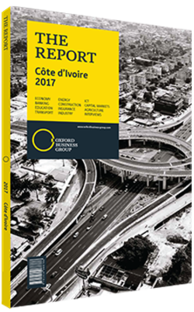Cote d'Ivoire's government aims for increased private participation
Côte d’Ivoire approved its second National Development Plan (Plan National de Développement, PND) in early 2016 to cover the 2016-20 period, following on from the 2012-15 PND. The new plan is aimed at transforming Côte d’Ivoire into an emerging country by 2020, has the backing of the World Bank and the IMF, and is focused on addressing structural issues and channelling investment into key sectors.
Under the 2016-20 PND, Côte d’Ivoire intends to invest upwards of CFA30bn (€45m), of which CFA11.3bn (€17m) will be earmarked for the public sector while CFA18.7bn (€28m) will be allocated to the private sector, according to an IMF report.
2012-15 National Development Plan
Created immediately after the country’s civil conflict ended in 2011, Côte d’Ivoire’s previous PND, which ran for four years up to 2015, was intended to help sustain the country’s economic recovery in the wake of several years of instability. Its aims were to re-establish security and a lawful state, consolidate the reconciliation and peace process, relaunch the economy and improve Côte d’Ivoire’s image.
Reform Agenda
The reforms carried out under the 2012-15 plan included security sector reform, the consolidation of local administrations across the country, the creation of a Truth and Reconciliation Commission, and reform of the coffee and cocoa sectors, along with the introduction of new electricity and mining codes. It also saw the creation of the National Development of the Financial Sector Plan.
The plan was generally considered a success. During the years that it covered the country saw annual headline growth average almost 9%. Importantly, the private sector contributed significantly to the 2012-15 PND’s implementation, with capital channelled to projects in priority sectors such as power provision. Private investment in the national grid, for example, facilitated the connection of 800 additional rural communities.
According to the IMF, the private sector invested upwards of CFA4.7bn (€7.1m) in the PND between 2012 and 2014, a figure that was well above the predicted level of CFA3.95bn (€5.9m).
Human Development & Infrastructure
Undefined The plan emphasised a number of human development sectors, and a recruitment drive for education staff under the PND created many new jobs. It also implemented initiatives to provide mothers and children with free health care and medicine, and broke ground on more than 70 public housing projects.
Wider access to ICT is also a key priority. “The government’s mid-term objective is to digitalise the country through a ‘one computer for one Ivorian’ programme. With this in mind, it is reducing taxes on computer equipment,” René Yédiéti, chairman and CEO of Librairie de France, told OBG.
The PND also targeted transport and utilities infrastructure, and saw the completion of several major engineering projects, including the northern highway connecting Singrobo to the administrative capital Yamoussoukro, as well as the Riviera II highway interchange and two new bridges in Abidjan.
Some 300 km of paved highways and 5000 km of rural roads were also built as part of the PND, as were an additional 794 water pumps and 76 water towers. All told, approximately 30,000 new jobs were created in 2013 and a further 40,000 in 2014. Many of these jobs were the result of an extensive recruitment drive for educational staff that was a fundamental part of the 2012-15 PND’s improvements to the education sector.
The gross primary school admission rate increased from 73.4% in 2008 to 97.8% in 2014, while the gross school enrolment rate rose from 76.2% to 94.7% over the same period, according to the IMF. Additionally, 9291 primary school classrooms were built, along with 3500 secondary school classrooms and 45 middle schools across the country.
Onward & Upward
The 2016-20 PND has at its heart three pillars. The first is diversifying Côte d’Ivoire’s industrial fabric by investing in areas where the country has a competitive advantage. The second is improving the transformation rate of natural resources and agriculture. The third involves consolidating the mining sector by simplifying the permit acquisition process and local production.
Specific objectives of the 2016-20 plan include supporting strong, lasting and sustainable growth, increasing added value through the transformation of raw products such as cocoa, coffee and cotton, improving the business environment, and fostering good governance and regional integration.
One of the most prominent ways in which the government is looking to do this is through public-private partnerships (PPPs). Within the agriculture sector, it is looking to use PPPs to boost the processing of agricultural products, including cashew and cotton, among others. The government hopes that PPP projects will help drive the process of industrialisation in the country.
Support For Sme Financing
Additionally, the 2016-20 PND will aim to address the fundamental structural issue of access to financing for small and medium-sized enterprises (SMEs).
More than 80% of all registered companies in Côte d’Ivoire are SMEs, yet they account for relatively small figures in terms of bank loans, GDP contribution and employment. Support for improving SME transparency and organisational structures – as well as measures to ease traditional banks into accepting higher levels of risk – are likely to form part of the 2016-20 PND in the years to come (see analysis).
New Avenues For Growth
In aiming for a continuation of the private sector development that took place during the 2012-15 PND, the government intends to lead a number of structural reforms during the 2016-20 PND that will foster the right conditions for strengthening the contribution of the private sector to the national economy.
You have reached the limit of premium articles you can view for free.
Choose from the options below to purchase print or digital editions of our Reports. You can also purchase a website subscription giving you unlimited access to all of our Reports online for 12 months.
If you have already purchased this Report or have a website subscription, please login to continue.

